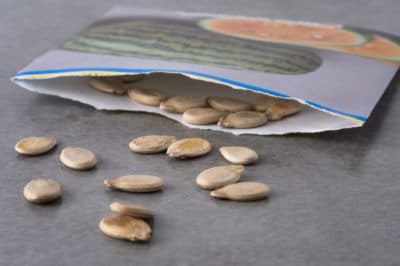Temperature Counts
The proper temperature is very important when it comes to the appropriate time to plant watermelon seeds. Watermelons are very sensitive to cold weather, with seeds failing to germinate and plants failing to thrive or even die.
Therefore, it’s important to wait until there is no longer a threat of an unexpected frost in your area before planting watermelon seeds or plants outdoors. The preferred temperatures for the germination of seeds and growth of plants are:
- The best temperatures for germination are between 70°F to 95°F (21.1°C to 35°C). Germination occurs in a couple of days, when seeds are planted in 95°F (35°C) and can take a week, when planted in 70°F (21.1°C).
- Watermelons thrive when planted and grown with temperatures ranging between 70°F and 85°F (21.1°C and 29.4°C), but still handle temperatures of 90°F (32.2°C).
Expert Tip: Help the garden area’s soil in warming up by covering the bed with black plastic in late winter or early spring.
Prepping for Planting
When selecting an area of the garden to grow watermelons, consider they are space hogs and vines can grow 20 feet long, depending on the particular variety. For the best growth and production of flowers and fruits:
- Select a weed-free area that receives full sun for the majority of the day.
- Plant seeds and grow in fertile soil that drains well. Amend the soil with well-rotted compost or manure.
Prepping Containers
If you lack space in the garden, you can grow watermelons in containers. Select a variety that doesn’t produce extremely long vines. Varieties that produce smaller fruits are suitable for growing vertically, which takes up even less space. Just make sure the structure the vines grow upon is sturdy and won’t fall over. Container preparation includes:
- Any type of container works well as long as it’s at least 5-gallons (18.9 liters) and has bottom drainage.
- Fill the container with a rich potting mix that drains well.
- Situate the container in a sunny location.
Varieties for Containers
Some watermelon cultivars suitable for growing in containers as well as growing up a trellis include:
- ‘Yellow Doll’ is a hybrid producing 3- to 7-pound, yellow-fleshed melons green-striped skin. Semi-compact vines mature in 68 to 80 days.
- ‘Snack Pack’ produces 3- to 4-pound fruits, with dark green skin and red flesh. Matures in around 75 days.
- ‘Solitaire’ is a seedless hybrid that stores well and produces red-fleshed, 4- to 6-pounds fruits, with dark green-striped skin. Matures in about 88 days.
Planting the Seeds
Gardeners wanting to get a jump on watermelon season can start the seeds indoors in peat pots about two to four weeks before the last frost. Once the temperatures warm, you can plant the entire pot in the garden without disturbing the sensitive root system.
Once outdoor temperatures warm, you can sow the watermelon seeds directly in the garden, planting them about 1/2 inch deep in mounds. Plant about six seeds in each mound and thin to the healthiest three seedlings. Space multiple mounds about 3 feet apart and space multiple rows about 8 feet apart.
Water the watermelon seeds after planting and keep the area moist but not soggy while the seeds germinate. Depending on the temperature, seeds should germinate in anywhere from three to seven days.
